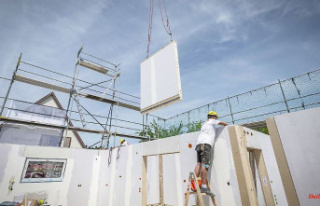In 1992 Gunter Demnig laid the first stumbling block in Cologne to commemorate the victims of the Nazi regime. There are now 96,000 in several countries - a life's work. And Demnig, who is celebrating his 75th birthday today, has already set himself the next goal.
When Gunter Demnig commemorated the Nazi deportations of Sinti and Roma in 1940 with an art event in the south of Cologne in May 1990, an elderly lady approached him. "Yes, good man," she said, "what you are doing here on the street is really nice." But Sinti and Roma would never have lived in their neighborhood. Demnig showed her historical evidence. "The woman's chin really dropped," remembers Demnig. "That was actually the trigger." For more than 30 years now, the Berlin-born artist has devoted himself to the memory of those who were once simply neighbors and one day disappeared - expelled, kidnapped, murdered by racist fanatics of the Nazi regime.
On December 16, 1992, Demnig laid his first "stumbling block" in Cologne. In Germany and many other countries, 96,000 of these small, metal-studded cuboids are now lying in front of houses where the victims once lived. Gunter Demnig turns 75 today. But he doesn't think about quitting. In June 2023 he wants the 100,000. set a stumbling block. The stones with the date of birth, the year of deportation and the presumed fate of the people bring passers-by to pause in many places, dozens of them lie on sidewalks in Berlin and other large cities - one stumbling block for each victim. Demnig says he is getting more and more inquiries from all over the world, from relatives who would like at least this small memento in Germany for their parents or grandparents who were murdered in the Shoa and who find comfort in it.
But there was always criticism. Demnig himself tells of resistance from city councillors, department heads and property owners who feared for the value of their houses. He received death threats from the right and 800 stones were destroyed over the years. But the most outspoken rejection came from former President of the Central Council of Jews in Germany, Charlotte Knobloch. In 2014 Knobloch said in the Munich City Council: "In my mind's eye I see the people who were already being kicked on while they were lying on the ground and who were kicked into the vans with heavy leather, steel-toed boots. People crouching on the ground, injured , dying or already dead, as is usual in the concentration camps. All of this can be seen as if it had happened yesterday. This memory is the reason for my unswerving resistance to any form of commemoration on the ground - especially to the "stumbling blocks".
The city of Munich decided against this type of memory. Demnig has counter-arguments. Before laying the first stone, he asked a Cologne rabbi for advice, and he had no objections, says the artist. "They aren't tombstones." The current President of the Central Council, Josef Schuster, is also behind the project. The Central Council writes on its website that "the stumbling blocks are a very good and dignified way of commemorating the victims of the Shoah". "Through the stumbling blocks, people come into contact with the topic in everyday life in a surprising and unforeseen way."
Demnig himself seems like a man who is at peace with himself. In the online interview, as in almost all of the photos, he is wearing his felt hat. In between, a cat struts across his desk in Alsfeld-Elbenrod, a village between Frankfurt and Kassel. The cat knocks over a cup. Demnig can not be disturbed. The man, who began studying art in Berlin in 1967 and later moved to Kassel and Cologne, tells of "laying tours" from place to place, planned and prepared by a team of eleven people. His wife Katja is in charge of the database, and an employee checks the facts provided by applicants. Demnig is annoyed that three possible Nazi sympathizers were honored during a relocation campaign for the Foreign Office in 2021. As an exception, he relied on research by the authorities. "When mistakes happen, the mistakes are corrected," he says. That has not yet been clearly clarified.
Demnig also does not accept accusations of money-making. It costs 120 euros to lay a stumbling block in Germany and 132 euros abroad. Once he had trouble with the tax office, which was unable to recognize any art in the project. The responsible state finance minister "crammed" him out, says Demnig. The art in his work is not every single stone. In the sense of Josef Beuys, it is a "social sculpture" - the physical object combined with the meeting of the people involved.
Above all, the fact that he reaches young people is what drives the artist, who himself learned little about the Nazi era in history classes and from his father, who had returned from the war. He was initially warned about the young people's lack of interest, but he experienced the opposite. History suddenly becomes tangible and close for students through the individual fates. Some start researching people who have been abducted from their communities and collect donations. "You just know why you're doing it," says Demnig.












